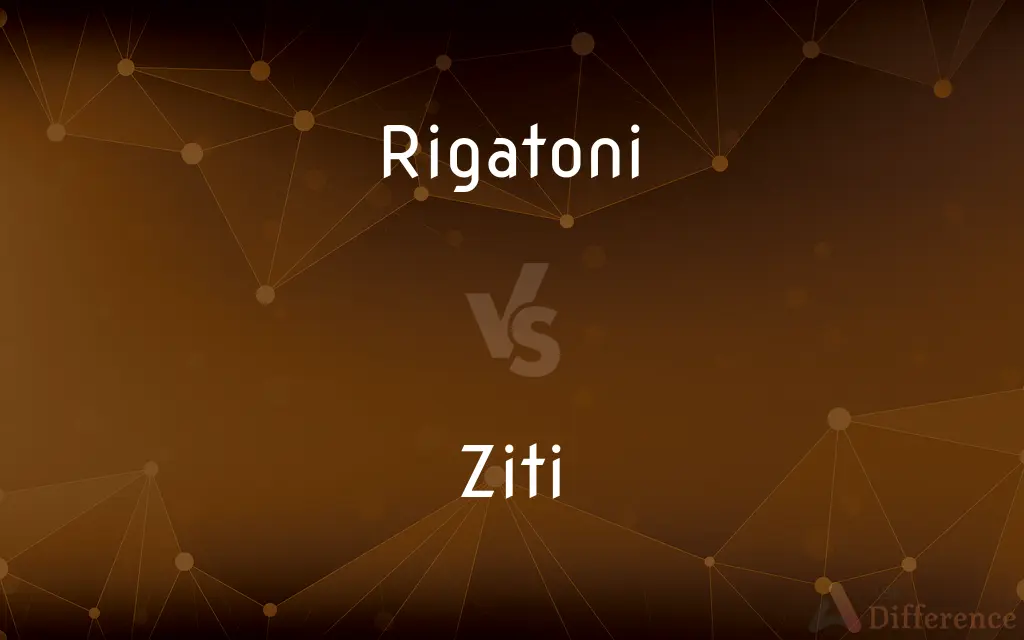Rigatoni vs. Ziti — What's the Difference?
By Tayyaba Rehman & Fiza Rafique — Updated on September 14, 2023
Rigatoni is a pasta shaped like large tubes and often has ridges, while Ziti is also tubular but is generally smooth and slightly smaller. Both are commonly used in Italian dishes.

Difference Between Rigatoni and Ziti
Table of Contents
ADVERTISEMENT
Key Differences
Rigatoni is a type of Italian pasta that is shaped like large tubes, often having ridges on the exterior. Ziti, on the other hand, is another form of Italian pasta but is generally smooth and comes in slightly smaller tubes. Both types of pasta are typically made from wheat and water.
In culinary applications, Rigatoni is often used in dishes that have thicker sauces, as its ridges are excellent for holding onto sauces. Ziti, with its smoother surface, is commonly used in baked dishes, often layered with cheeses and sauces like marinara or meat sauce.
When it comes to texture, Rigatoni offers a more substantial bite due to its larger and thicker size. Ziti provides a somewhat softer bite because of its smaller size and smooth surface, making it easier to cook in less time.
In terms of language and spelling, both Rigatoni and Ziti are Italian words that have been assimilated into English. Rigatoni comes from the Italian word "rigato," meaning ridged, while Ziti possibly derives from the word "zita," meaning bride, as it's traditionally served at Italian weddings. Both terms are nouns in English and are not typically converted into verbs or other forms of speech.
Comparison Chart
Shape
Large tubes with ridges
Smaller tubes, generally smooth
ADVERTISEMENT
Common Uses
Thicker sauces
Baked dishes
Texture
Substantial bite
Softer bite
Cooking Time
Longer due to size
Generally quicker due to smaller size
Etymological Origin
From Italian "rigato" (ridged)
Possibly from Italian "zita" (bride)
Compare with Definitions
Rigatoni
A large, tubular pasta with ridges.
The rigatoni held onto the Bolognese sauce well.
Ziti
A small, tubular, and generally smooth pasta.
The ziti was perfect for the baked casserole.
Rigatoni
Commonly used in dishes with thicker sauces.
I prefer rigatoni for my creamy Alfredo dish.
Ziti
Cooks more quickly due to its smaller size.
The ziti was ready in just seven minutes.
Rigatoni
Made from wheat and water.
This rigatoni is made from whole-wheat flour.
Ziti
Made from wheat and water.
This ziti is actually gluten-free.
Rigatoni
Offers a substantial, chewy bite.
The rigatoni's texture made the dish more satisfying.
Ziti
Often used in baked pasta dishes.
We layered the ziti with cheese and marinara sauce.
Rigatoni
Derived from the Italian word "rigato."
Rigatoni translates to ridged in English.
Ziti
Traditionally served at Italian weddings.
Ziti is often known as the bride's pasta.
Rigatoni
Rigatoni (Italian: [riɡaˈtoːni]) are a form of tube-shaped pasta of varying lengths and diameters originating in Italy. They are larger than penne and ziti, and sometimes slightly curved, though not as curved as elbow macaroni.
Ziti
Ziti is an extruded pasta, originating in Campania. It is shaped into a long, wide tube, about 25 cm long, that needs to be broken by hand into smaller pieces before cooking.
Rigatoni
Pasta in the form of short hollow fluted tubes.
Ziti
Pasta in the form of tubes resembling large macaroni.
Rigatoni
Pasta in ribbed, slightly curved, large-sized tubes.
Ziti
Pasta in medium-sized, often ridged tubes.
Rigatoni
A ribbed tubular form of pasta, larger than penne but with square-cut ends, often slightly curved.
Ziti
A type of macaroni pasta in the form of long smooth hollow tubes.
Rigatoni
Tubular pasta in short ribbed pieces
Ziti
Medium-sized tubular pasta in short pieces
Common Curiosities
What are common dishes for Rigatoni?
Rigatoni is often used in dishes with thicker, meatier sauces.
What is Rigatoni?
Rigatoni is a large, ridged, tubular pasta.
What is Ziti?
Ziti is a smaller, generally smooth, tubular pasta.
How does Rigatoni differ from Ziti in shape?
Rigatoni has ridges and is larger, while Ziti is smooth and smaller.
What does Ziti mean?
Ziti possibly comes from the Italian word "zita," meaning "bride."
Is Rigatoni good for holding sauces?
Yes, the ridges in Rigatoni help hold sauces well.
Is Ziti gluten-free?
Only if made from gluten-free ingredients.
What are common dishes for Ziti?
Ziti is commonly used in baked pasta dishes like ziti al forno.
Which pasta cooks faster?
Ziti generally cooks faster due to its smaller size.
What does Rigatoni mean?
Rigatoni is derived from the Italian word "rigato," meaning "ridged."
Is Ziti good for baked dishes?
Yes, Ziti is commonly used in baked pasta dishes.
Which pasta has a more substantial bite?
Rigatoni has a more substantial, chewy bite.
Can I substitute Rigatoni for Ziti?
Yes, but expect a change in texture and sauce adherence.
Is Rigatoni gluten-free?
Only if made from gluten-free ingredients.
Are both Rigatoni and Ziti Italian?
Yes, both types of pasta originate from Italy.
Share Your Discovery

Previous Comparison
Skipper vs. Captain
Next Comparison
Cancel vs. CancellationAuthor Spotlight
Written by
Tayyaba RehmanTayyaba Rehman is a distinguished writer, currently serving as a primary contributor to askdifference.com. As a researcher in semantics and etymology, Tayyaba's passion for the complexity of languages and their distinctions has found a perfect home on the platform. Tayyaba delves into the intricacies of language, distinguishing between commonly confused words and phrases, thereby providing clarity for readers worldwide.
Co-written by
Fiza RafiqueFiza Rafique is a skilled content writer at AskDifference.com, where she meticulously refines and enhances written pieces. Drawing from her vast editorial expertise, Fiza ensures clarity, accuracy, and precision in every article. Passionate about language, she continually seeks to elevate the quality of content for readers worldwide.
















































